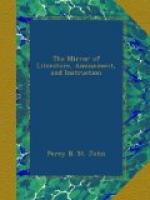VILLAS IN THE REGENT’S PARK
[Illustration: Hanover Lodge.]
[Illustration: Grove house.]
The villas of this district are among the most pleasing of all the architectural creations that serve to increase its picturesque beauty. Their structure is light and elegant, and very different from the brick and mortar monstrosities that line the southern outlets of London.
The engravings on the annexed page represent two of a group seen to advantage from Macclesfield Bridge, pictured in our 351st Number. The first is
Hanover Lodge,
the residence of Colonel Sir Robert Arbuthnot, K.C.B. The architectural simplicity and beauty of this mansion can scarcely fail to excite the admiration of the beholder. The entrance is by a handsome portico; and the internal accommodations combine all the luxuries of a well-proportioned dining-room, and a splendid suite of drawing-rooms, extending above sixty feet in length, by eighteen feet in breadth. The upper story comprises nine chambers, bathing-room, dressing-rooms, &c.; and the domestic offices are in the first style of completeness.
The grounds are unusually picturesque, for they have none of the geometrical formalities of the exploded school of landscape-gardening, or of Nature trimmed and tortured into artificial embellishment. We have often wondered where the old gardeners acquired their mathematical education; they must have gone about with the square and compasses in their pockets—for knowledge was then clasped up in ponderous folios.
The second engraving is
Grove house,
the elegant residence of George Bellas Greenough, Esq., built from the designs of Mr. Decimus Burton. This is a happy specimen of the villa style of architecture. The garden front, represented in the print, is divided into three portions. The centre is a tetrastyle portico of the Ionic order, raised on a terrace. Between the columns are three handsome windows. The two wings have recesses, “the soffites of which are supported by three-quarter columns of the Doric order. Between these columns are niches, each of which contains a statue. The absence of other windows and doors from the front,” (observes Mr. Elmes,) “gives a remarkable and pleasing casino or pleasure-house character to the house.”
The portico is purely Grecian, and the proportion of the pediment very beautiful. The entrance front also consists of a centre and two wings; but the former has no pediment. The door is beneath a spacious semicircular portico of the true Doric order, which alternates with the Ionic in the other parts of the building with an effect truly harmonious.
Of the internal arrangements of Grove House we will vouch; but our artist has endeavoured to convey some idea of the natural beauties with which this little temple of art is environed; and the engraver has added to the distinctness of the floral embellishments in the foreground. Altogether, the effect breathes the freshness and quiet of a rural retreat, although the wealth and fashion of a metropolis herd in the same parish, and their gay equipages are probably whirling along the adjacent road.




